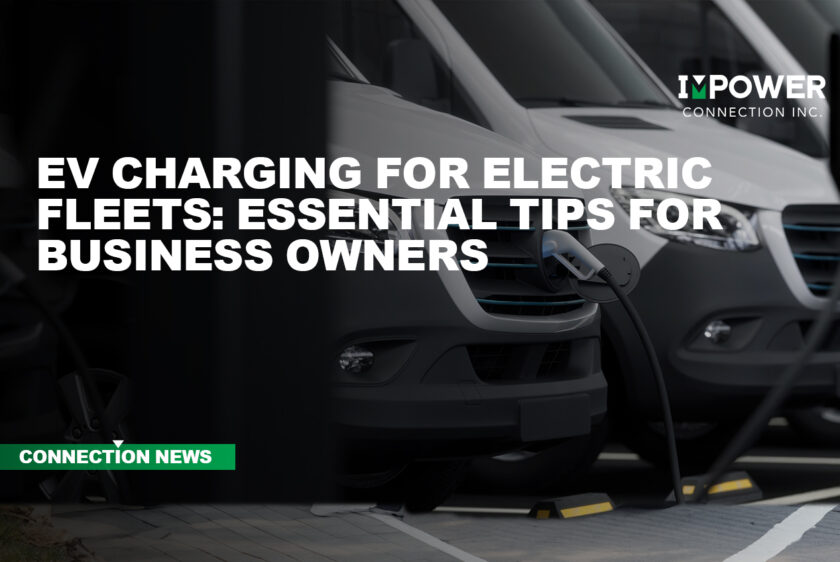Some automotive companies have committed to solely focus on Electric Vehicles (EVs) by 2030. There is a strong likelihood that almost 50% of all cars produced will be EVs by that year. Businesses and government entities will be impacted by this shift, and increasingly embark on electrification of their fleets. As fleet electrification gains momentum, it’s crucial for business owners and other fleet operators to navigate the world of EV charging in a way that ensures efficient operations and maximizes the benefits of electric vehicles. Impower Connection, America’s choice for EV chargers, installations, grant consulting and maintenance, offers the following essential tips for implementing EV charging solutions for electric fleets.
Understand Your Fleet’s Charging Needs:
Charging Infrastructure Assessment: Evaluate your fleet’s charging requirements by considering the number of vehicles, their daily mileage, and expected charging patterns. Assessing these factors will help determine the necessary charging infrastructure capacity and location planning.
Fleet Charging Demands: Identify peak charging periods and develop a charging schedule to ensure a balanced load distribution. Understanding your fleet’s charging demands enables you to optimize charging times, minimize downtime, and efficiently utilize available charging resources.
Charging Infrastructure Scalability: The share of electric cars among the overall car market rose from about 4% in 2020, to 14% in 2022. It’s set to increase to 18% in 2023. The growth trend doesn’t show any signs of slowing down. To keep pace, it’s essential to plan for future growth by designing a scalable charging infrastructure that can accommodate the expansion of your electric fleet. Anticipate potential increases in the number of vehicles and adapt your charging infrastructure to support future demand.
Optimize Charging Infrastructure Design:
Charging Station Placement: Strategically position charging stations within your fleet’s operating area for easy accessibility. Consider factors such as parking availability, proximity to charging equipment, and the convenience of drivers during charging sessions.
Charging Station Types: Three levels of charging are available in the U.S. Determine the appropriate charging station types based on your fleet’s needs. Consider Level 2 chargers for overnight charging and faster DC fast chargers for quick top-ups during the day. Impower Connection recommends having a mix of charging station types ensures flexibility and efficiency.
Load Management and Power Distribution: Load management is the process of balancing how much electricity is used at any given time. The goal is to keep electrical loads under infrastructure capacity. Load management is especially important for commercial entities with multiple EVs. Fleet operators can implement load management systems to optimize power distribution and prevent overwhelming electrical circuits. This helps balance the power load across charging stations, avoiding unnecessary strain on your electrical infrastructure.
Efficient Charging Management
Smart Charging Solutions: Smart charging involves managing how electric vehicles are charged by connecting to the grid. Fleet operators should utilize smart charging solutions that provide advanced features such as scheduling, remote monitoring, and energy management. Smart charging systems optimize charging sessions based on electricity rates, grid demand, and available renewable energy sources, ensuring cost-effective and environmentally friendly charging.
Fleet Charging Management Platforms: Consider utilizing fleet charging management platforms that enable centralized control and monitoring of charging sessions. These platforms provide real-time data, analytics, and billing management to streamline fleet charging operations.
Employee Education and Training: Educate your drivers and employees on the basics of EV charging, including how to use charging stations correctly and efficiently. Promote good charging etiquette, such as minimizing charging time and avoiding unnecessary idle time, to maximize charging availability for all vehicles.
Partner with an Experienced EV Charging Provider:
Consultation and Expertise: Partner with an experienced EV charging provider, like Impower Connection, for a turn-key solution to adopting a charging system. This approach allows experts to guide you through the entire process. That expertise ensures you have the right charging infrastructure, scalable solutions, and ongoing support for your fleet’s charging needs.
Comprehensive Service and Maintenance: Choose a provider that offers comprehensive service and maintenance packages to ensure the optimal performance and reliability of your charging infrastructure. Regular maintenance and prompt repairs minimize downtime and maximize fleet efficiency.
Ongoing Support: Seek a provider that offers dedicated customer support to address any technical issues, provide guidance, and assist with charging infrastructure management. Ongoing support ensures smooth operations.
Conclusion:
Successfully implementing EV charging solutions for electric fleets requires careful planning, optimized infrastructure design, efficient charging management, and the right partnerships. There are common sense tips that business operators and government entities can follow. Yet the best way to avoid costly mistakes is leveraging the expertise of a turn-key provider that can evaluate your needs, design and install a customized EV charging system, and then provide long-term maintenance to make getting and operating commercial EV charging stations hassle-free.
Impower Connection is experienced in the unique challenges and requirements of fleet electrification. Our comprehensive fleet charging solutions, consultation services, and ongoing support ensure a seamless transition to electric mobility for your business.
Visit www.impowerconnection.com to unlock the benefits of EV charging for your business.







